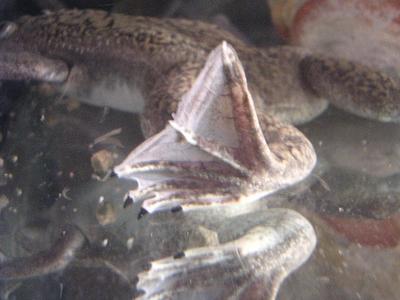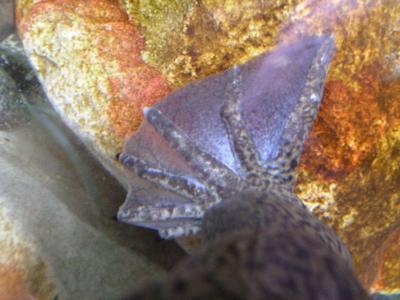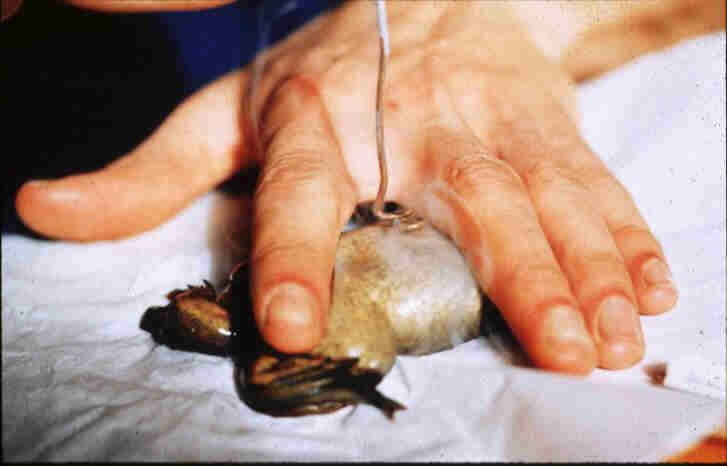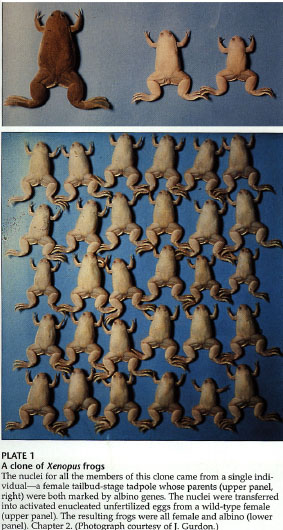|
Pregnancy Testing
In the 1940's-1950's there were no store bought pregnancy tests. A woman who suspected she was pregnant would go to a
clinic and give a sample of her urine to the doctor. He would then inturn inject her urine into a female Xenopus laevis. If
the female frog layed eggs the woman was pregnant, if not then the woman wasn't pregnant. When more modern methods came along
the frogs were no longer needed so they were released into streams, ponds and small lakes in parts of California
and other states. They have since established wild populations and have been destroying native frog species.
Labratory Research
Xenopus laevis are mainly used in labratory research to study vertebrate embryology. They make a remarkable research
animal due to the fact that the females are prolific egg layers. They embryos are also transparent so they are easy to observe
in the developmental stages. They are also long lived, hardy and easy to care for in a labratory setting.
Polydactyl Xenopus laevis
Some labs overseas are producing polydactyl Xenopus laevis. These frogs have an extra digit on their hands and feet.
Leaving them with 6 toes and 5 fingers (instead of the normal 5 toes and 4 fingers). This is a genetic defect but does not
affect the frogs health. Thanks to Melody for sharing this with me!
| Xenopus laevis Polydactyl |

|
| 6 toes on hind foot |
| Xenopus laevis Polydactyl |

|
| 6 toes on rear foot |
| Xenopus laevis Polydactyl |

|
| a 5th finger on her hand, looks like a thumb |
|
 |
 |
 |
Freeze Branding Xenopus
Freeze Branding Xenopus laevis was first used in 1976 as a way of indentifying an individual frog. This is an effective
way of permanantly marking xenopus so they easily be told apart and reduce the amount of mixups in a labratory setting.
This also could be used to identify and study wild populations of xenopus species, especially those who are declining. But
for the most part this practice has been neglected by herpetologists.
| Xenopus Laevis being branded |

|
| Copper wire is bent into the shape of numbers and dipped in liquid nitrogen |
| Xenopus Laevis |

|
| Branded with an identification number |
|
 |
 |
 |
|
Xenopus in Space
The space shuttle Endeavour launched into space on September 12, 1992 and with it went the first japanese astronaut,
the first american woman astronaut and African Clawed Frogs! Scientists wanted to know if reproduction and development could
be at normal levels in zero gravity. So they raised xenopus laevis tadoples to test this theory.
Glowing Frogs
Researchers are combining a gene from a Xenopus laevis with green flourescent protein from a jellyfish. This creates
frogs with eyes and nervous systems that GLOW a neon green! They are currently using this method of research for eye genetics.
| xenopus laevis tadpole |

|
| glowing due to jellyfish DNA |
Cloning
What was the first invertebrate ever cloned? if you guessed Dolly the sheep you are WRONG! Our very own African Clawed
Frog (xenopus laevis) was the first invertebrate ever cloned and they are still cloned quite frequently in present day labs
for genetic research.
| Xenopus Laevis |

|
| Albino Clones |
|
 |
|
|
|

